With analysis, finding suitable things is easier. Proper knowledge and pure information must be needed for your passion. If you are a shooter, you need a deep understanding of the BCG.
Because it’s a very important element for your shooting, we analyze everything about 300 Blackout rifles BCG in this article. Let’s go.
What is BCG?
BCG means “Bolt Carrier Group.” These are very important elements for automatic and semi-automatic firearms. It is responsible for cycling the firearm, extracting and ejecting spent cartridge cases, and chambering new rounds for firing.
Its operation is integral to semi-automatic and automatic firearms functioning, allowing for continuous and efficient firing as long as the shooter holds down the trigger.
Features of a BCG
Bolt: The bolt is a cylindrical component with locking lugs that rotates and locks into the barrel extension when the firearm is in a battery (ready to fire). The bolt houses the firing pin and extractor.
Carrier: The carrier is a larger, solid metal piece surrounding the bolt. It reciprocates back and forth within the upper receiver during the firing cycle and guides the bolt’s movement.
Gas Key: Located on the carrier’s top, the gas key connects to the gas tube in the AR-15’s gas system. Gas from the burning gunpowder is directed through the gas system, pushing the BCG rearward to cycle the firearm.
Firing Pin: It is a small pin within the bolt. When the trigger is pulled, the firing pin strikes the cartridge’s primer, initiating ignition.
Extractor: The extractor is a hook-shaped part on the bolt that grips the rim of the spent cartridge case during the extraction phase. It pulls the spent case out of the chamber during the rearward movement of the BCG.
Ejector: The ejector is a small component located in the receiver opposite the extractor. It kicks the spent cartridge case out of the firearm through the ejection port during the ejection phase.
Cam Pin: The cam pin is a small cylindrical pin that fits into a cam slot in the bolt carrier and interacts with the upper receiver’s barrel extension, causing the bolt to rotate and lock or unlock during the firing cycle.
Firing Pin Retaining Pin: This small pin secures the firing pin within the bolt and prevents it from moving freely.
Coating: Some BCGs come with various coatings to enhance durability, reduce friction, and resist corrosion. Common coatings include phosphate, nickel boron, and black nitride.
Weight Reduction Cuts: Some BCGs have lightning cuts or reliefs to reduce the overall weight of the BCG, which can affect the rifle’s recoil and cycling characteristics.
MPI and HPT Testing: MPI (Magnetic Particle Inspection) and HPT (High-Pressure Testing) are quality control processes used during manufacturing to ensure the BCG’s integrity and safety.
What is 300 Blackout BCG?
With smooth firing, you can properly use your gun. BCG works for it. The Bolt Carrier Group (BCG) is the heart and soul of your .300 Blackout rifle and any other semi-automatic or automatic firearm.
With this critical component, your rifle is rendered useful. BCGs are engineered to ensure the smoothest possible firing patterns, preventing frustrating glitches and jams when properly maintained.
If you’ve experienced frequent jams or headaches during reloading, chances are the BCG is to blame. The bolt within the BCG plays a crucial role in guiding the next round from the magazine into the chamber, preparing your rifle for the next shot.
A high-quality BCG is your first line of defense against jams, ensuring seamless shooting and reloading as you engage in your shooting pursuits.
Choosing a reliable and well-crafted BCG can make all the difference in optimizing the performance and reliability of your .300 Blackout rifle, guaranteeing a satisfying and hassle-free shooting experience.
Why is BCG needed?
These are the main factors needed for BCG.
Cycling the Firearm: The BCG is responsible for the cyclic operation of the firearm. When a round is fired, gas from the burning gunpowder is directed through the gas system (in gas-operated rifles), pushing the BCG rearward.
This rearward movement cycles the firearm, extracting and ejecting the spent cartridge case and chambering a new round for firing.
Chambering and Extracting Rounds: The BCG ensures the proper chambering of a new round from the magazine into the firing chamber and extracting the spent cartridge case after firing.
Locking the Bolt: During the firing cycle, the bolt within the BCG locks into the barrel extension, ensuring a secure and sealed chamber. This locking action contributes to the safe and controlled firing of the firearm.
Cocking and Resetting the Hammer: The BCG’s rearward movement cocks the hammer, preparing the firearm for the next shot. As the BCG moves forward, the hammer is released, striking the firing pin and initiating the ignition of the next round.
The forward movement of the BCG also resets the trigger, allowing the firearm to be fired again.
Gas Operation (in Gas-Operated Firearms): In gas-operated rifles, the BCG plays a crucial role in harnessing the high-pressure gas generated by the burning gunpowder to cycle the firearm.
The gas is directed through the gas port in the barrel into the gas system and pushes the BCG rearward, initiating the extraction and ejection of the spent cartridge case.
Sealing the Chamber: The BCG helps seal the chamber during firing, containing the pressure generated by the fired round. This sealing action contributes to efficient gas system use and ensures reliable cycling.
Best BCG for 300 Blackout
There are many BCGs available in the market. Discuss the all-over sector we find the best BCG for your 300 Blackout.
1. Aero Precision Bolt Carrier Group (BCG)
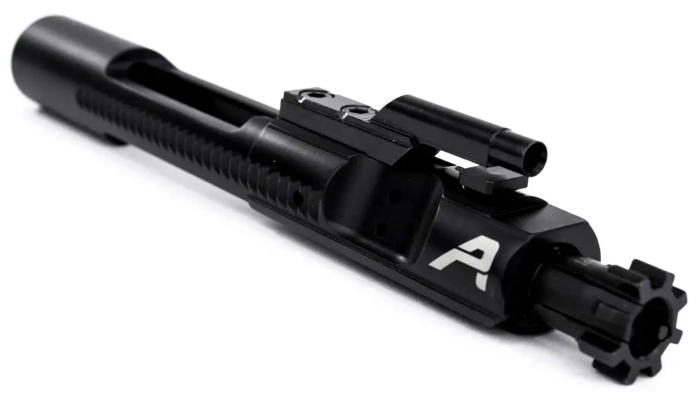
This is the most popular BCG. It comes with many features such as:
Carrier: The carrier is the main body of the BCG, usually made from high-quality steel. It houses the bolt and moves back and forth within the upper receiver to cycle the firearm. Aero Precision carriers are precisely machined to ensure smooth operation and reliability.
Gas Key: The gas key is attached to the carrier’s top and interfaces with the gas tube in a direct impingement gas-operated system.
When gas is directed from the fired round, it enters the gas key, forcing the carrier backward to initiate the cycling process. Its gas keys are staked securely to prevent them from loosening during use.
Gas Key Screws: These are tiny screws that hold the gas key securely on the carrier. They are tightened and staked to ensure they don’t come loose during operation.
Bolt: The bolt is a critical component of the BCG, responsible for locking into the barrel extension and containing the pressure generated by firing the round.
These bolts are typically made from high-strength steel and precision machined to tight tolerances for reliability.
Extractor: The extractor is responsible for gripping the rim of the spent casing and pulling it out of the chamber after firing. These extractors are designed to provide positive and consistent extraction.
Extractor Spring: The extractor spring provides tension to the extractor, ensuring it maintains a firm grip on the spent casing during extraction.
Extractor O-ring (optional): Some BCGs have an O-ring around the extractor, which can help improve extraction and ejection reliability.
Ejector: The ejector is responsible for kicking the spent casing out of the ejection port. Aero Precision BCGs typically have a reliable and durable ejector.
Cam Pin: The cam pin is a cylindrical pin that holds the bolt within the carrier while allowing it to rotate during cycling. Its cam pins are precisely machined for smooth operation.
Firing Pin: The firing pin is responsible for striking the round’s primer and igniting the powder to fire the projectile. Its firing pins are made to be durable and reliable.
2. FailZero EXO Nickel Boron BCG
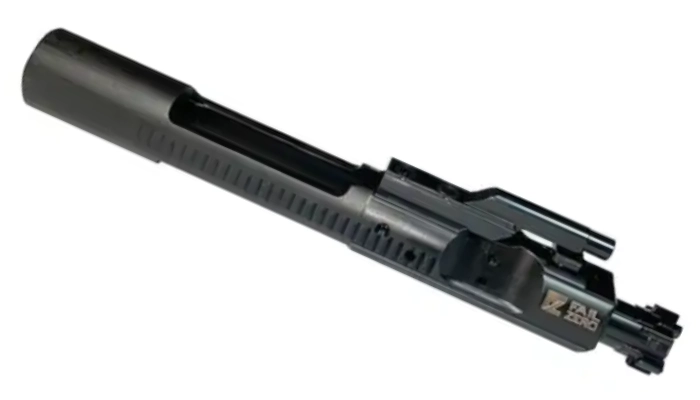
Carrier: The FailZero EXO BCG features a page coated with a Nickel Boron (NiB) finish. The NiB coating offers several benefits, including increased lubricity, easy cleaning, and reduced friction, resulting in smoother operation and reliability.
Gas Key: It comes with a gas key that also features the same Nickel Boron coating as the carrier for enhanced durability and easy cleaning.
Gas Key Screws: These are tiny screws that hold the gas key securely on the carrier. In the FailZero EXO BCG, these screws are also coated with Nickel Boron.
Bolt: The FailZero EXO BCG features a bolt with a Nickel Boron coating, providing increased hardness and smooth operation.
Extractor: The FailZero EXO BCG typically comes with an extractor coated with Nickel Boron for enhanced reliability and easy cleaning.
Extractor Spring: It is a standard spring used in AR-15 BCGs.
Extractor O-ring (optional): Some BCGs, including the FailZero EXO BCG, may have an O-ring around the extractor, which can help improve extraction and ejection reliability.
Ejector: The FailZero EXO BCG has an ejector typically made from durable steel.
Cam Pin: The cam pin in the FailZero EXO BCG is often coated with Nickel Boron for smoother operation.
Firing Pin: The FailZero EXO BCG usually includes a firing pin coated with Nickel Boron for increased reliability and easy cleaning.
3. Toolcraft 300 BLK M16 Profile Bolt Carrier Group
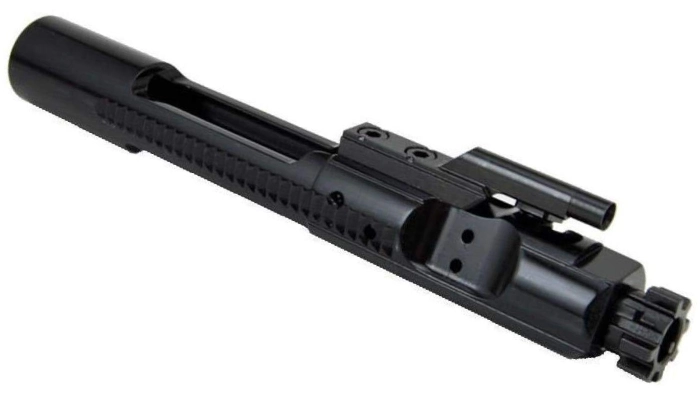
Carrier: Its carrier is made from high-quality steel. Toolcraft carriers are precisely machined to tight tolerances for reliable and smooth operation.
Gas Key: Toolcraft BCGs usually have a gas key staked securely to the carrier to prevent it from loosening during use.
Gas Key Screws: These are tiny screws that hold the gas key in place on the carrier. The screws are tightened and staked to ensure they remain secure during operation.
Bolt: Its bolts are typically made from high-strength steel and precision machined for reliable performance.
Extractor: Toolcraft extractors are designed for positive and consistent extraction.
Extractor Spring: The extractor spring provides tension to the extractor, ensuring it maintains a firm grip on the spent casing during extraction.
Extractor O-ring (optional): Some Toolcraft BCGs may have an O-ring around the extractor, which can help improve extraction and ejection reliability.
Ejector: These BCGs typically come with a reliable and durable ejector.
Cam Pin: Its cam pins are precisely machined for smooth operation.
Firing Pin: Toolcraft firing pins are made to be durable and reliable.
4. LMT Enhanced Bolt Carrier Group (BCG)
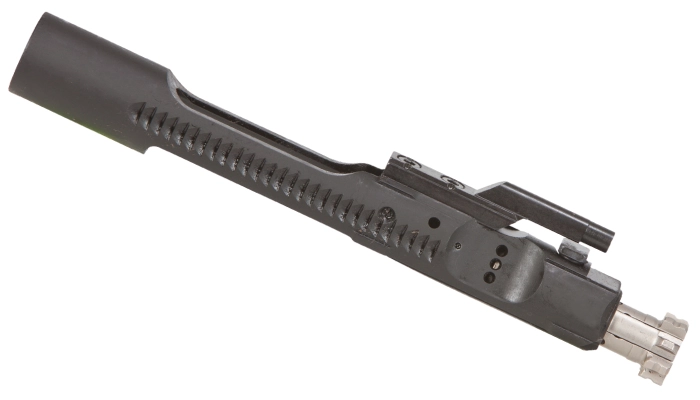
Carrier: It is usually made from high-quality steel. LMT Enhanced BCGs are precisely machined to strict tolerances to ensure smooth operation and enhanced reliability.
Gas Key: These BCGs come with a properly staked gas key to add security and prevent loosening during use.
Gas Key Screws: These are tiny screws that hold the gas key securely on the carrier. The screws are tightened and staked to ensure they remain secure during operation.
Bolt: It typically features a precisely machined bolt made from high-strength steel.
Extractor: LMT Enhanced BCGs are designed to offer reliable and positive extraction.
Extractor Spring: The extractor spring provides tension to the extractor, ensuring it maintains a firm grip on the spent casing during extraction.
Extractor O-ring (optional): Some BCGs, including the LMT Enhanced BCG, may have an O-ring around the extractor, which can help improve extraction and ejection reliability.
Ejector: The ejector is responsible for kicking the spent casing out of the ejection port. It typically comes with a reliable and durable ejector.
Cam Pin: These BCGs have a precisely machined cam pin for smooth operation.
Firing Pin: It comes with a durable and reliable firing pin.
5. Bravo Company Manufacturing (BCM) BCG
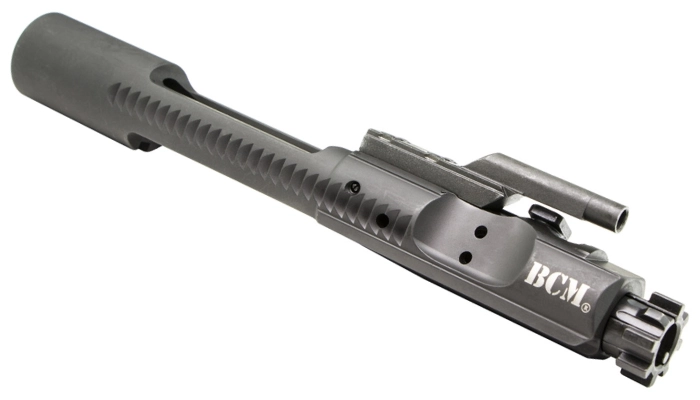
Carrier: These BCGs are precisely machined to tight tolerances to ensure smooth operation and reliability.
Gas Key: BCGs come with a properly staked gas key to prevent it from loosening during use.
Gas Key Screws: These are tiny screws that hold the gas key securely on the carrier. The screws are tightened and staked to ensure they remain secure during operation.
Bolt: These BCGs typically feature a precision-machined bolt made from high-strength steel.
Extractor: BCM BCGs are designed to offer reliable and positive extraction.
Extractor Spring: The extractor spring provides tension to the extractor, ensuring it maintains a firm grip on the spent casing during extraction.
Extractor O-ring (optional): Some BCGs, including some BCM models, may have an O-ring around the extractor, which can help improve extraction and ejection reliability.
Ejector: It typically comes with a reliable and durable ejector.
Cam Pin: It has a precisely machined cam pin for smooth operation.
Firing Pin: These BCGs come with a durable and reliable firing pin.
Aspects are focusing on choosing 300 Blackout BCG
Budget: BCGs come in various price ranges, so consider your budget and find a BCG that balances quality and affordability.
Materials and Construction: Look for a BCG made from high-quality materials, such as Carpenter 158 or 8620 steel. The components should be precisely machined and heat-treated to ensure durability and longevity.
Compatibility: Ensure the BCG is specifically designed and chambered for .300 Blackout. While most BCGs for 5.56 NATO or .223 Remington will work with .300 Blackout, it’s essential to double-check compatibility to ensure proper functioning.
Coating: Consider BCGs with special coatings like nickel boron or black nitride. These coatings reduce friction, enhance corrosion resistance, and make cleaning easier, contributing to smoother operation and reliability.
Gas System: If you plan to shoot supersonic and subsonic ammunition, look for a BCG optimized for both types. Some BCGs may have adjustable gas blocks or modified gas ports to accommodate different loads effectively.
Enhanced Firing Pin: To ensure reliable ignition, some .300 Blackout BCGs come with enhanced firing pins, which can be beneficial, especially when using subsonic ammunition.
MPI and HPT Testing: Look for BCGs that have undergone Magnetic Particle Inspection (MPI) and High-Pressure Testing (HPT) during manufacturing to ensure the integrity and safety of the components.
Weight: Consider the weight of the BCG, as it can impact the rifle’s recoil and cycling characteristics. Some BCGs have weight reduction cuts to reduce mass while maintaining structural integrity.
Conclusion
Here we are focusing on BCG and the best BCG for the .300 Blackout gun. The best .300 Blackout BCG should be specifically designed for .300 Blackout rifles, made from high-quality materials, and feature a reliable coating for reduced friction and enhanced corrosion resistance.
Consider BCGs with optimized gas systems for supersonic and subsonic ammunition, and look for reputable manufacturers known for producing reliable firearm components.
A BCG that balances quality and affordability while being easy to maintain will optimize your .300 Blackout rifle’s performance and reliability.
Hi, I’m Brent Hansford. A writer turned hunter & now sharing my love for the sport through writing. As I practically breathe weapons, I firmly believe I’m capable of providing you with new knowledge about firearms and hunting. My mission is to help more people get better at hunting & master the weapons. Let me help with unleashing the beast within you!

